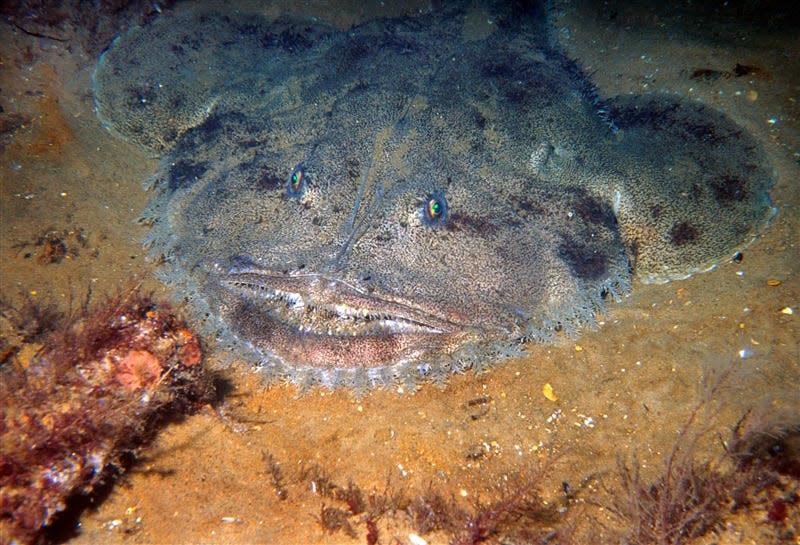Monkfish: ‘The poor man’s lobster’ that's now a delicacy for the rich
This is my last article for the summer. The Oceanarium will be closing the day after Labor Day and the animals will make their way back to the ocean. I thought that I would end the summer with one of my favorite fish, the monkfish.
Many of you may have eaten this as a “poor man’s lobster.” To be honest, I have never eaten it. They were worth so much that when my husband was fishing for them, he would not bring one home.
They are sold as monk tails and the livers are sent over to Asian countries as a delicacy. I just love the way it looks.

Monkfish, also known as goosefish, for centuries were thought of as a trash fish getting their nickname from the monks who would go to the fishermen begging for leftovers.
The fishermen gave them their trash fish thus this angler fish received the nickname “monkfish.”
They look a little like the Cheshire cat in Alice in Wonderland, with a huge wide thin mouth tapering like a triangle to its tail. Their mouth and throat are full of very sharp, very pointed, lethal-looking teeth. The teeth all along its mouth are moveable, flattening down against its palate to allow food to “swim” well into its gut. It has two wide pectoral fins that look almost like two front paws. On its top jaw, it has a protrusion that appears to be a tiny fishing rod hanging over its mouth. There is a small extension of loose skin hanging at the end that can wiggle like a worm.
They're not what you think: Taking a closer look at sand dollars on Hampton Beach
The monkfish remains still on the ocean floor and waits for an unsuspecting animal to swim by and try to eat the “worm” on its head. The worm is a modified dorsal fin. Once an animal is close enough to touch the “worm” the monkfish mouth automatically opens and closes over the prey and is swallowed. Sometimes they will use their pectoral fins to push off the seabed and jump up while chomping an unsuspecting fish. A true angler fish, its jaw opens and closes so fast that it could not be caught on film with a normal camera until strobe photography was invented by Harold Edgerton of MIT, and was finally captured by a West German photographer in the late 1960s.
Atlantic hagfish: A slimy ‘nightmare’ of a fish that feeds on the dead
Monkfish live on the ocean floor throughout the Eastern coast of North America from coastal areas out to 3,000 feet and can grow to 50 pounds and up to 4 feet in length.
According to the National Oceanic and Atmospheric Administration (NOAA) website, the females are larger than the males and live longer. They bury themselves in the silt on the ocean floor waiting for unsuspecting prey and have been known to eat animals larger than themselves as their stomach and skin are able to stretch to accommodate the larger fish! Just imagine, a 40-pound fish swallowing a 50-pound cod! My husband once caught a large female with a 12-pound wolf fish and a 10-pound bluefish in its stomach, both of which are apex predators in their own right.
Swordfish sightings: Apex predator, with few enemies, is not like the cartoon
Amazingly the monkfish migrate large distances to feed and spawn. They can swim but often just “walk” along the ocean floor with their pectoral fins, like a giant lumbering Cheshire cat. Females lay a sheet of gelatinous eggs which float along with the currents on the surface of the ocean for up to three weeks until they hatch into their larval form. They have been known to lay over a million eggs at a time. And woe be to the male monkfish who doesn’t escape quick enough after mating as he will become her next meal!
Moon snails: The unique creature that eats other snails and clams
I have spoken to fishermen here in the Gulf of Maine who swear that fishing for monkfish is a dangerous proposition. They claim that the large females are testy and often jump out of the fish bins to bite the unlucky crewman who is sorting fish. Most often they must remove the animal from their boots but occasionally they lodge onto a crewman’s arm, and it takes two or three other crewmen to extricate it.
Monkfish have been known to eat seabirds and the unsuspecting diving duck!
So, like a Cheshire cat, I leave you with the mental picture of a fish swallowing a duck!
Wishing you all a beautiful autumn. I will see you at the Oceanarium next spring.
Ellen Goethel is a marine biologist and the owner of Explore the Ocean World at 367 Ocean Blvd. at Hampton Beach.
This article originally appeared on Portsmouth Herald: Monkfish: ‘The poor man’s lobster’ that's now a delicacy for the rich

